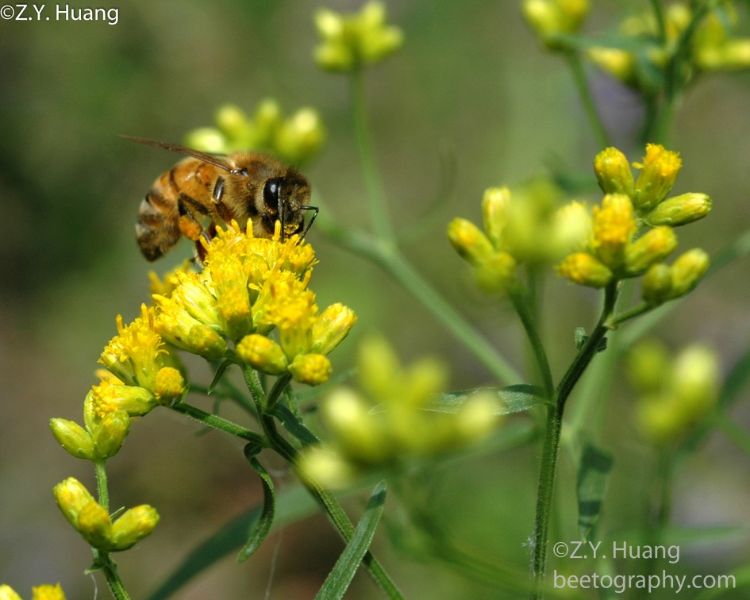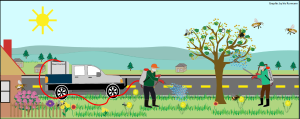September resources for Michigan beekeepers
Beekeepers in Michigan can learn about seasonal honey bee colony management and care through webinars, videos and other online resources.

In September, some colonies may bring in nectar while others may benefit from receiving feed. While varroa mite levels often spike in the fall, management done earlier in the season may lead to lower mite levels. Beekeepers can access the following online resources, including webinars and videos, to stay informed, ask questions and work to keep honey bee colonies healthy.
September beekeeping webinar and webinar recordings from past years
Join Michigan State University Extension for September Michigan Beekeeping Office Hours on Monday, Sept. 8 at 7 p.m. The 2025 series of Michigan Beekeeping Office Hours webinars will focus time for answering beekeeping questions.
Beekeeping webinar series in past years included presentations on seasonal beekeeping management. Beekeepers can watch these presentations in the September 2024 Michigan Beekeeping Office Hours webinar recording and September 2023 Michigan Beekeeping Office Hours webinar recording. Additional webinar recordings are available on the Michigan State University Beekeeping YouTube channel and at Michigan State University Extension beekeeping and pollinator videos.
The best way for Michigan State University (MSU) Extension to answer beekeeping questions is through monthly Michigan Beekeeping Office Hours webinars. If you need to ask questions outside of the webinars and you live in Michigan, submit your question through the Michigan beekeeping Ask Extension form.
Honey bee nutrition and feeding
- Honey Bee Nutrition from the Honey Bee Health Coalition - guide
- Feeding honey bees - article
- Honey bee plants - list of photos
Winter bees
Wintering configurations
- The Condensing Hive Concept with Dr. David Peck and Bill Hesbach - video
- Beekeeping Manuals from University of Minnesota Bee Lab
- Wrapping Honey Bee Colony for a Northern Winter from the University of Minnesota Bee Lab - step-by-step guide
- Wrapping Honey Bee Colony for a Northern Winter with Tar Paper from the University of Minnesota Bee Lab - step-by-step guide
Varroa mites and honey bee diseases
- Tools for varroa management from the Honey Bee Health Coalition - guide (Spanish version: La versión completa en español de las Herramientas para la Gestión de Varroa)
- Varroa mite treatments not included in the 8th Edition of the Honey Bee Health Coalition's Tools for Varroa Management guide - article (Spanish version: Varroa mite treatments not included in the 8th Edition of the Honey Bee Health Coalition's Tools for Varroa Management guide)
- Diagnostic tools for honey bee diseases - online learning module
- European foulbrood office hours - webinar recording
- Michigan honey bee veterinarians - contact list
- Find a bee vet from the Honey Bee Veterinary Consortium - contact list
General beekeeping resources
- Apiculture programs and resources from MSU Extension
- Getting started with beekeeping in Michigan
- Is Beekeeping Right for Me? - online course
- Ask Extension form for Michigan residents to ask beekeeping questions
- List of Michigan beekeeping clubs from Michigan Beekeepers Association
- Beekeeping in Northern Climates Manual from the University of Minnesota Bee Lab
Websites, email newsletter and social media
- MSU Extension Beekeeping & Pollinators website
- Michigan Pollinator Initiative website
- MSU Extension Beekeeping & Pollinators events
- MSU Extension Beekeeping & Pollinators email newsletter
- Michigan State University Beekeeping YouTube channel
- Michigan State University Beekeeping Facebook page
- Michigan Pollinator Initiative Facebook page
Acknowledgments
This work is supported by the Crop Protection and Pest Management Program [grant no 2024-70006-43569] from the USDA National Institute of Food and Agriculture.
Any opinions, findings, conclusions, or recommendations expressed in this publication are those of the authors and do not necessarily reflect the view of the U.S. Department of Agriculture.



 Print
Print Email
Email
